Thermo-Mechanical Stress Distributions in a Ceramic Matrix Composites Turbine Vane Coated with Environmental Barrier Coatings
Abstract
1. Introduction
2. Numerical Modeling
2.1. Geometric Description
2.2. Material Properties
2.3. Load and Boundary Conditions
2.4. Numerical Implementation
3. Results and Discussions
3.1. Stress Nephogram
3.2. Thermal Residual Stress
3.3. Stresses under Thermal Loads
3.4. Stresses under Couple Loads
4. Conclusions
Author Contributions
Funding
Institutional Review Board Statement
Informed Consent Statement
Data Availability Statement
Acknowledgments
Conflicts of Interest
References
- Sørensen, B.F.; Goutianos, S. Micromechanical model for prediction of the fatigue limit for unidirectional fibre composites. Mech. Mater. 2019, 131, 169–187. [Google Scholar] [CrossRef]
- Chen, B.; Ding, Q.; Ni, D.; Wang, H.; Ding, Y.; Zhang, X.; Dong, S. Microstructure and mechanical properties of 3D Cf/SiBCN composites fabricated by polymer infiltration and pyrolysis. J. Adv. Ceram. 2021, 10, 28–38. [Google Scholar] [CrossRef]
- Singh, S.; Singh, V.; Kumari, S.; Udayakumar, A.; Prasad, V.V.B. A comparative study of tensile strength of Cf/SiC composites having single layer and multilayer interphases. Ceram. Int. 2019, 45, 21193–21199. [Google Scholar] [CrossRef]
- Santhosh, U.; Ahmad, J.; Ojard, G.; Gowayed, Y. A synergistic model of stress and oxidation induced damage and failure in silicon carbide-based ceramic matrix composites. J. Am. Ceram. Soc. 2021, 104, 4163–4182. [Google Scholar] [CrossRef]
- Zhao, D.; Guo, T.; Fan, X.; Chen, C.; Ma, Y. Effect of pyrolytic carbon interphase on mechanical properties of mini T800-C/SiC composites. J. Adv. Ceram. 2021, 10, 219–226. [Google Scholar] [CrossRef]
- Parthasarathy, T.A.; Cox, B.; Sudre, O.; Przybyla, C.; Cinibulk, M.K. Modeling environmentally induced property degradation of SiC/BN/SiC ceramic matrix composites. J. Am. Ceram. Soc. 2018, 101, 973–997. [Google Scholar] [CrossRef]
- Song, C.; Liu, Y.; Ye, F.; Cheng, L.; Zhang, P.; Chai, N. Enhanced mechanical property and tunable dielectric property of SiCf/SiC-SiBCN composites by CVI combined with PIP. J. Adv. Ceram. 2021, 10, 758–767. [Google Scholar] [CrossRef]
- Min, J.B.; Xue, D.; Shi, Y. Micromechanics modeling for fatigue damage analysis designed for fabric reinforced ceramic matrix composites. Compos. Struct. 2014, 111, 213–223. [Google Scholar] [CrossRef]
- Patel, A.; Sato, E.; Takagi, T.; Shichijo, N. Bending fatigue behavior in an advanced SiC/SiC ceramic matrix composite component at elevated temperature in air. Compos. Part C Open Access 2021, 5, 100127. [Google Scholar] [CrossRef]
- Hou, G.; Shang, D.-G.; Zuo, L.-X.; Qu, L.-F.; Xia, M.; Wu, S.; Hao, G.-C. Fatigue life prediction of needled ceramic matrix composite under variable amplitude loading. Int. J. Fatigue 2022, 156, 106690. [Google Scholar] [CrossRef]
- Chen, X.; Cheng, G.; Yang, J.; Hu, J.; Liao, C.; Zhang, X.; Dong, S. Effects of interfacial residual stress on mechanical behavior of SiCf/SiC composites. J. Adv. Ceram. 2022, 11, 94–104. [Google Scholar] [CrossRef]
- Ruggles-Wrenn, M.B.; Noomen, M. Fatigue of unitized polymer/ceramic matrix composites with 2D and 3D fiber architecture at elevated temperature. Polym. Test. 2018, 72, 244–256. [Google Scholar] [CrossRef]
- Bondarchuk, D.A.; Fedulov, B.N.; Fedorenko, A.N.; Lomakin, E.V. Investigation into residual stresses inherited during manufacturing of carbon-epoxy composites with delamination. Procedia Struct. Integr. 2020, 28, 743–751. [Google Scholar] [CrossRef]
- You, T.; Li, T.; Zhai, X.; Du, C. Computation of the Thermal Residual Stresses in SiC/SiC Composites with Multi-Layered Interphases by Using ANN with the Structure of Random Forest. High Temp. Mater. Process. 2018, 37, 987. [Google Scholar] [CrossRef]
- Tejero-Martin, D.; Bennett, C.; Hussain, T. A review on environmental barrier coatings: History, current state of the art and future developments. J. Eur. Ceram. Soc. 2021, 41, 1747–1768. [Google Scholar] [CrossRef]
- Fang, G.; Ren, J.; Shi, J.; Gao, X.; Song, Y. Thermal Stress Analysis of Environmental Barrier Coatings Considering Interfacial Roughness. Coatings 2020, 10, 947. [Google Scholar] [CrossRef]
- Lee, K.N.; Zhu, D.; Lima, R.S. Perspectives on Environmental Barrier Coatings (EBCs) Manufactured via Air Plasma Spray (APS) on Ceramic Matrix Composites (CMCs): A Tutorial Paper. J. Therm. Spray Technol. 2021, 30, 40–58. [Google Scholar] [CrossRef]
- Zhang, X.; Wang, C.; Ye, R.; Deng, C.; Liang, X.; Deng, Z.; Niu, S.; Song, J.; Liu, G.; Liu, M.; et al. Mechanism of vertical crack formation in Yb2SiO5 coatings deposited via plasma spray-physical vapor deposition. J. Mater. 2020, 6, 102–108. [Google Scholar] [CrossRef]
- Ye, C.; Jiang, P. Accurate residual stress measurement as a function of depth in environmental barrier coatings via a combination of X-ray diffraction and Raman spectroscopy. Ceram. Int. 2020, 46, 12613–12617. [Google Scholar] [CrossRef]
- Summers, W.D.; Poerschke, D.L.; Begley, M.R.; Levi, C.G.; Zok, F.W. A computational modeling framework for reaction and failure of environmental barrier coatings under silicate deposits. J. Am. Ceram. Soc. 2020, 103, 5196–5213. [Google Scholar] [CrossRef]
- Fang, G.; Gao, X.; Song, Y. A Review on Ceramic Matrix Composites and Environmental Barrier Coatings for Aero-Engine: Material Development and Failure Analysis. Coatings 2023, 13, 357. [Google Scholar] [CrossRef]
- Garcia, E.; Sotelo-Mazon, O.; Poblano-Salas, C.A.; Trapaga, G.; Sampath, S. Characterization of Yb2Si2O7–Yb2SiO5 composite environmental barrier coatings resultant from in situ plasma spray processing. Ceram. Int. 2020, 46, 21328–21335. [Google Scholar] [CrossRef]
- Bakan, E.; Mack, D.E.; Lobe, S.; Koch, D.; Vaßen, R. An investigation on burner rig testing of environmental barrier coatings for aerospace applications. J. Eur. Ceram. Soc. 2020, 40, 6236–6240. [Google Scholar] [CrossRef]
- Xiao, J.; Liu, Q.; Li, J.; Guo, H.; Xu, H. Microstructure and high-temperature oxidation behavior of plasma-sprayed Si/Yb2SiO5 environmental barrier coatings. Chin. J. Aeronaut. 2019, 32, 1994–1999. [Google Scholar] [CrossRef]
- Sullivan, R.M. Reformulation of oxide growth equations for oxidation of silicon bond coat in environmental barrier coating systems. J. Eur. Ceram. Soc. 2019, 39, 5403–5409. [Google Scholar] [CrossRef]
- Schlech, T.; Horn, S.; Wijayawardhana, C.; Rashidi, A. Experimental and FEM based investigation of the influence of the deposition temperature on the mechanical properties of SiC coatings. J. Adv. Ceram. 2021, 10, 139–151. [Google Scholar] [CrossRef]
- Richards, B.T.; Sehr, S.; de Franqueville, F.; Begley, M.R.; Wadley, H.N.G. Fracture mechanisms of ytterbium monosilicate environmental barrier coatings during cyclic thermal exposure. Acta Mater. 2016, 103, 448–460. [Google Scholar] [CrossRef]
- Abdul-Aziz, A.; Bhatt, R.T. Modeling of thermal residual stress in environmental barrier coated fiber reinforced ceramic matrix composites. J. Compos. Mater. 2012, 46, 1211–1218. [Google Scholar] [CrossRef]
- Fang, G.W.; Zhong, Y.; Sun, J.; Gao, X.G.; Song, Y.D. Synergetic effect of coating properties and fibrous architecture on stress evolution in plain-woven ceramic matrix composites. Compos. Interface 2022, 29, 141–159. [Google Scholar] [CrossRef]
- Harder, B.J.; Almer, J.D.; Weyant, C.M.; Lee, K.N.; Faber, K.T. Residual Stress Analysis of Multilayer Environmental Barrier Coatings. J. Am. Ceram. Soc. 2009, 92, 452–459. [Google Scholar] [CrossRef]
- Abdul-Aziz, A.; Wroblewski, A.C. Durability Analysis and Experimental Validation of Environmental Barrier Coating (EBCs) Performance Using Combined Digital Image Correlation and NDE. Coatings 2016, 6, 70. [Google Scholar] [CrossRef]
- Zhai, Z.; Wang, W.; Mei, X.; Li, M.; Cui, J.; Wang, F.; Pan, A. Effect of the surface microstructure ablated by femtosecond laser on the bonding strength of EBCs for SiC/SiC composites. Opt. Commun. 2018, 424, 137–144. [Google Scholar] [CrossRef]
- Lee, K.N.; Eldridge, J.I.; Robinson, R.C. Residual Stresses and Their Effects on the Durability of Environmental Barrier Coatings for SiC Ceramics. J. Am. Ceram. Soc. 2005, 88, 3483–3488. [Google Scholar]
- Fang, G.; Gao, X.; Song, Y. Coupled thermomechanical analysis of stress distributions in a ceramic matrix composites turbine vane considering the anisotropic properties. J. Phys. Conf. Ser. 2021, 1777, 012055. [Google Scholar]
- Zhu, W.; Wang, J.W.; Yang, L.; Zhou, Y.C.; Wei, Y.G.; Wu, R.T. Modeling and simulation of the temperature and stress fields in a 3D turbine blade coated with thermal barrier coatings. Surf. Coat. Technol. 2017, 315, 443–453. [Google Scholar] [CrossRef]
- Halila, E.E.; Lenahan, D.T.; Thomas, T.T. High Pressure Turbine Test Hardware Detailed Design Report; NASA CR-167955, General Electric Company Report; NASA: Washington, DC, USA, 1982.
- Shen, X.; Qiao, Y.; Dong, S.; Liu, X.; Gong, L. Thermal Load Test Method and Numerical Calculation for Ceramic Matrix Composite Turbine Guide Vane. Appl. Compos. Mater. 2019, 26, 553–573. [Google Scholar] [CrossRef]
- Wang, L.; Wang, Y.; Zhang, W.Q.; Sun, X.G.; He, J.Q.; Pan, Z.Y.; Wang, C.H. Finite element simulation of stress distribution and development in 8YSZ and double-ceramic-layer La2Zr2O7/8YSZ thermal barrier coatings during thermal shock. Appl. Surf. Sci. 2012, 258, 3540–3551. [Google Scholar] [CrossRef]
- Heveran, C.M.; Xu, J.; Sarin, V.K.; Basu, S.N. Simulation of stresses in TBC–EBCs coating systems for ceramic components in gas turbines. Surf. Coat. Technol. 2013, 235, 354–360. [Google Scholar] [CrossRef]
- Zhang, J.; Guo, X.; Jung, Y.-G.; Li, L.; Knapp, J. Lanthanum zirconate based thermal barrier coatings: A review. Surf. Coat. Technol. 2017, 323, 18–29. [Google Scholar] [CrossRef]
- Murthy, P.L.N.; Nemeth, N.N.; Brewer, D.N.; Mital, S. Probabilistic analysis of a SiC/SiC ceramic matrix composite turbine vane. Compos. Part. B Eng. 2008, 39, 694–703. [Google Scholar] [CrossRef]
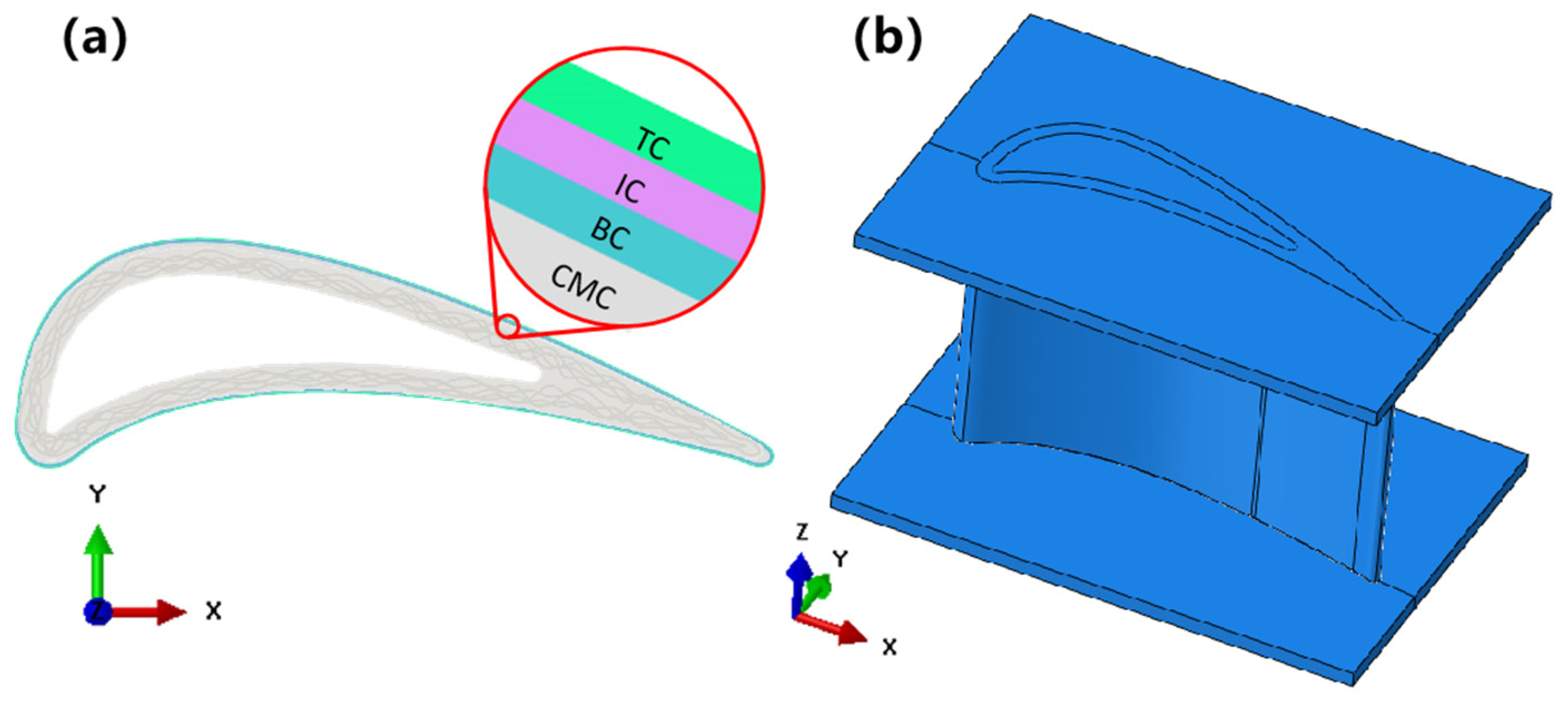
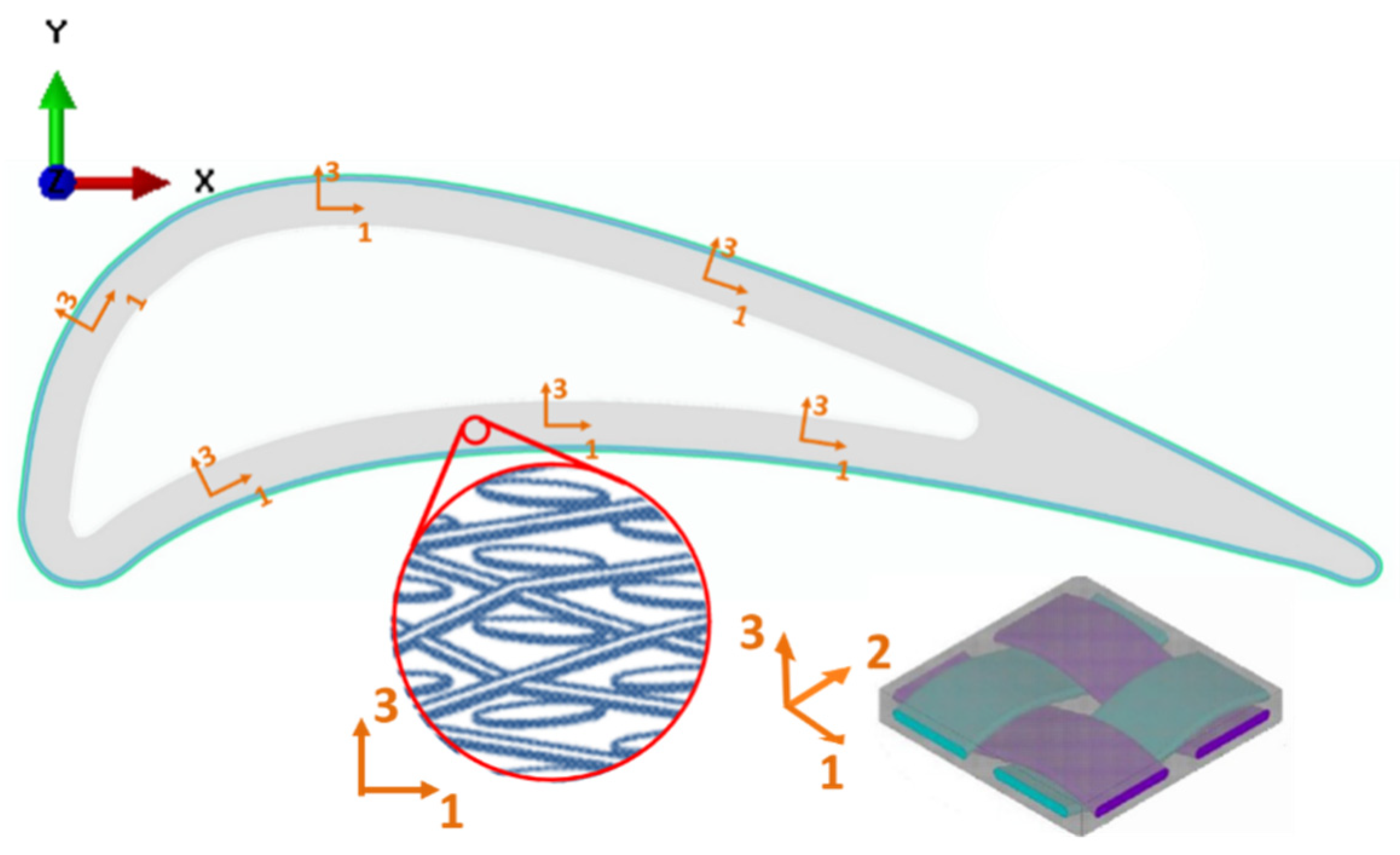
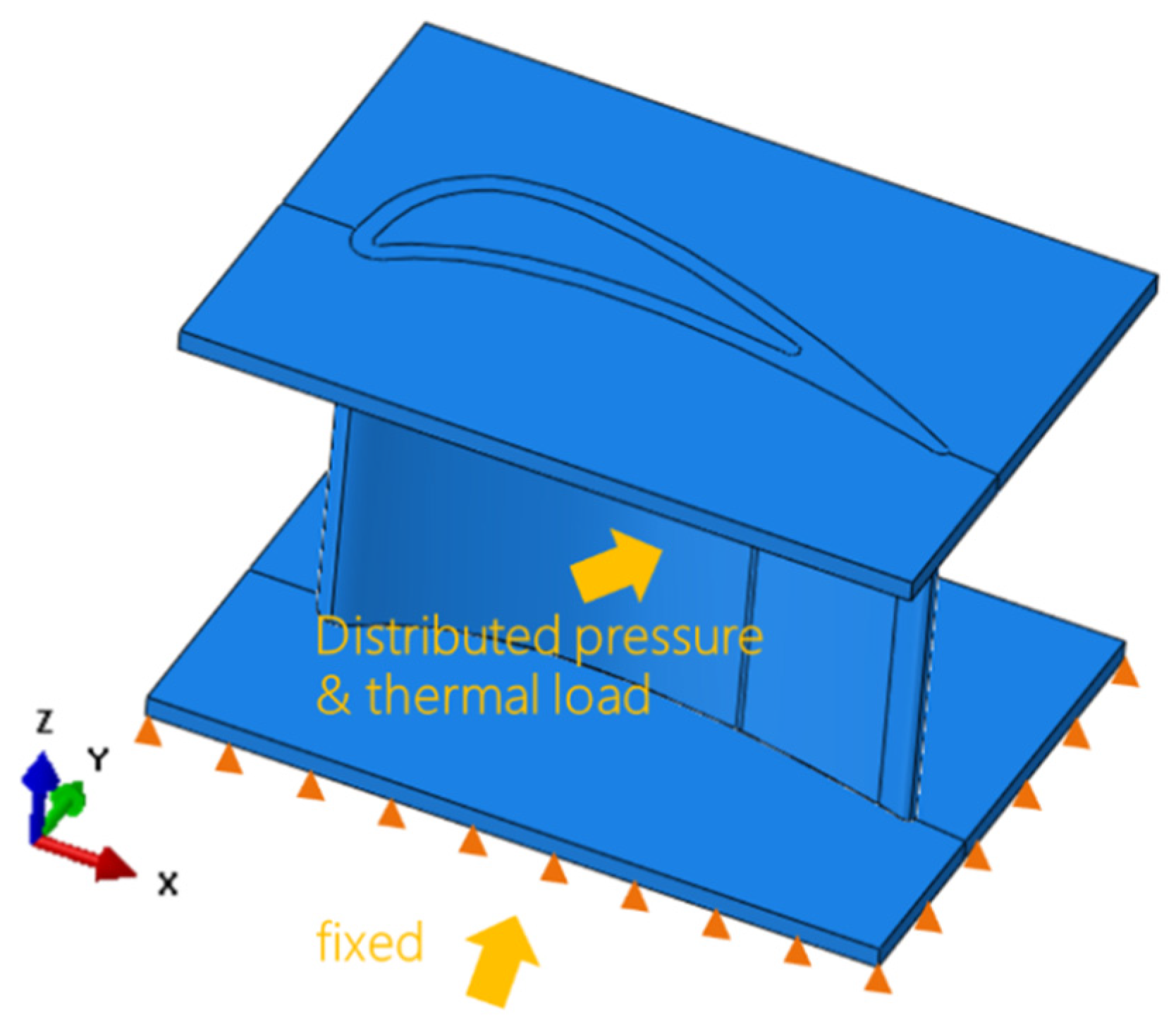
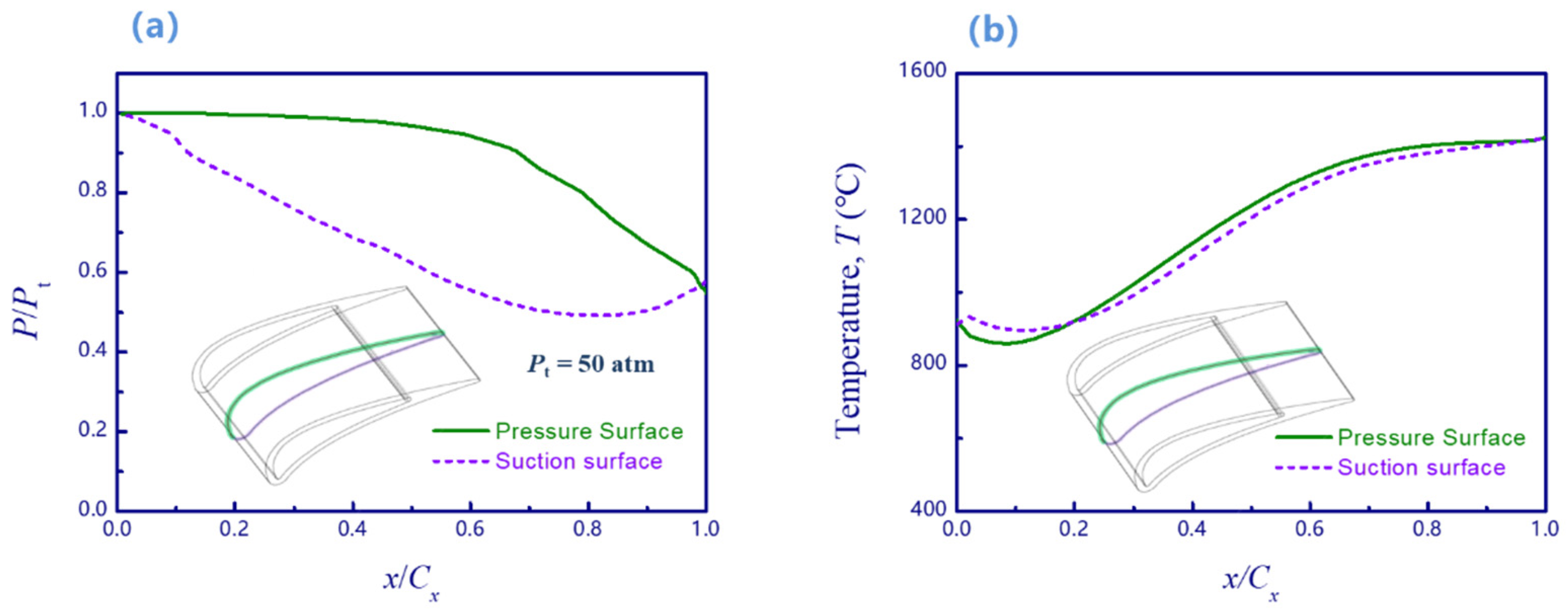
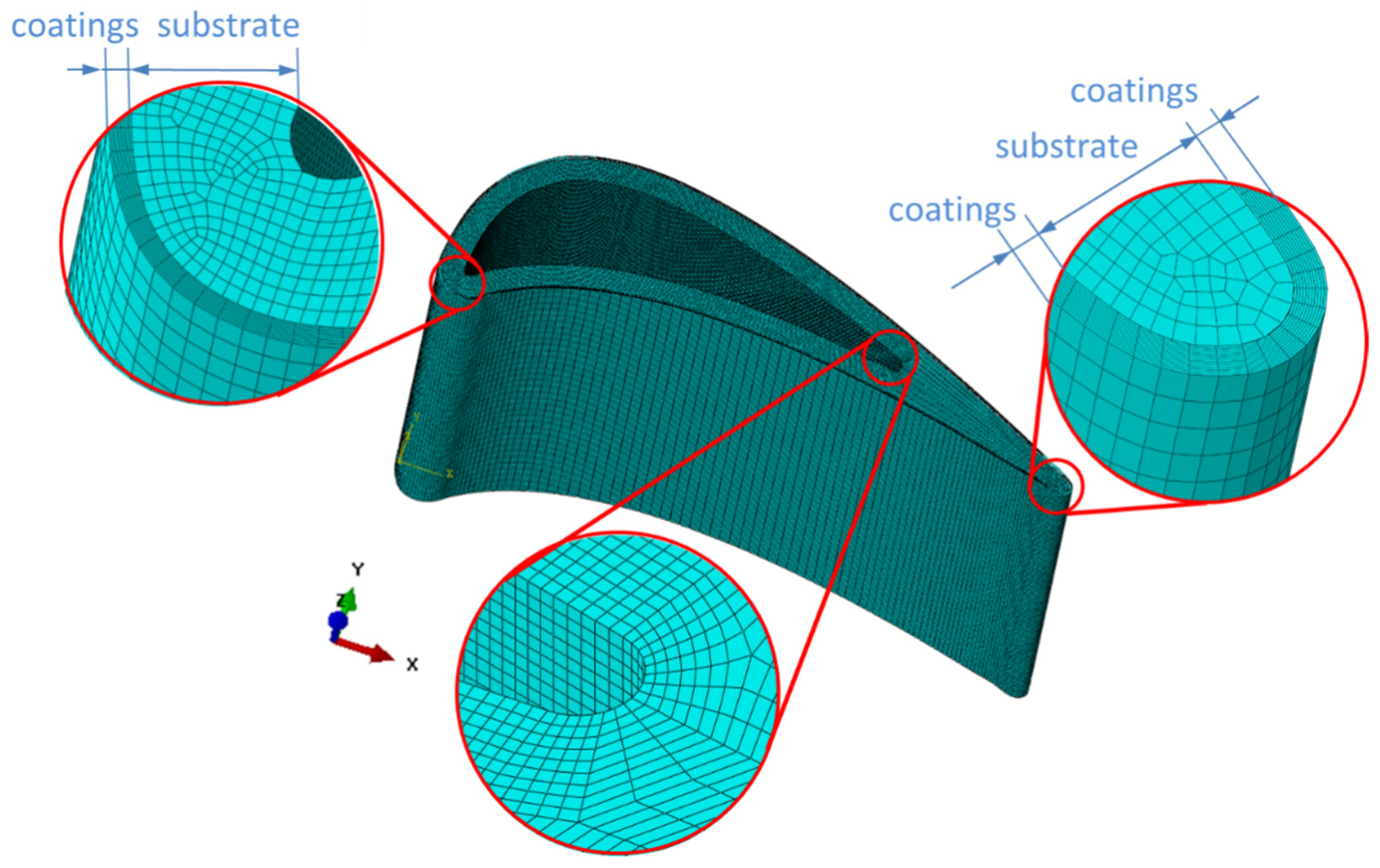
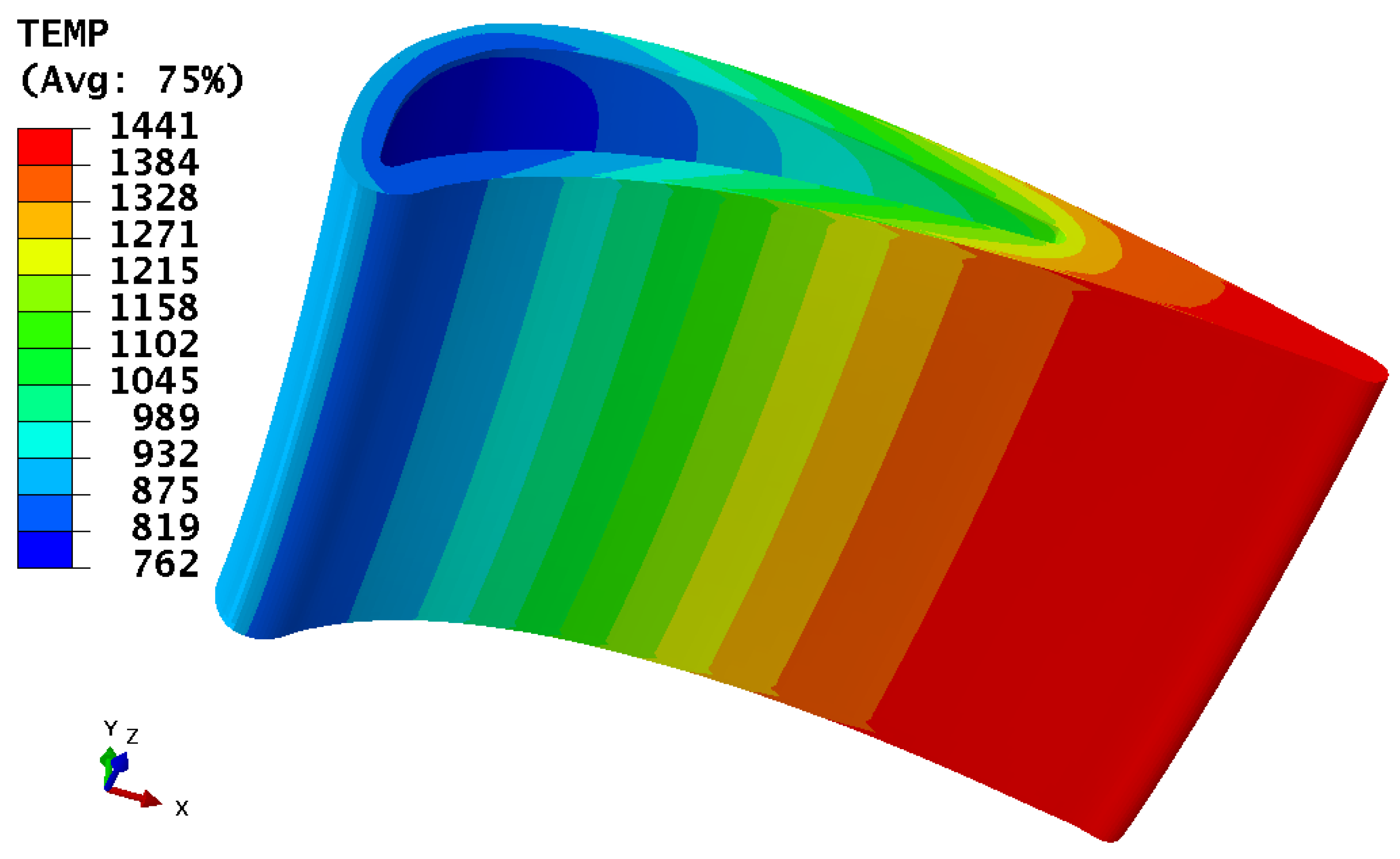
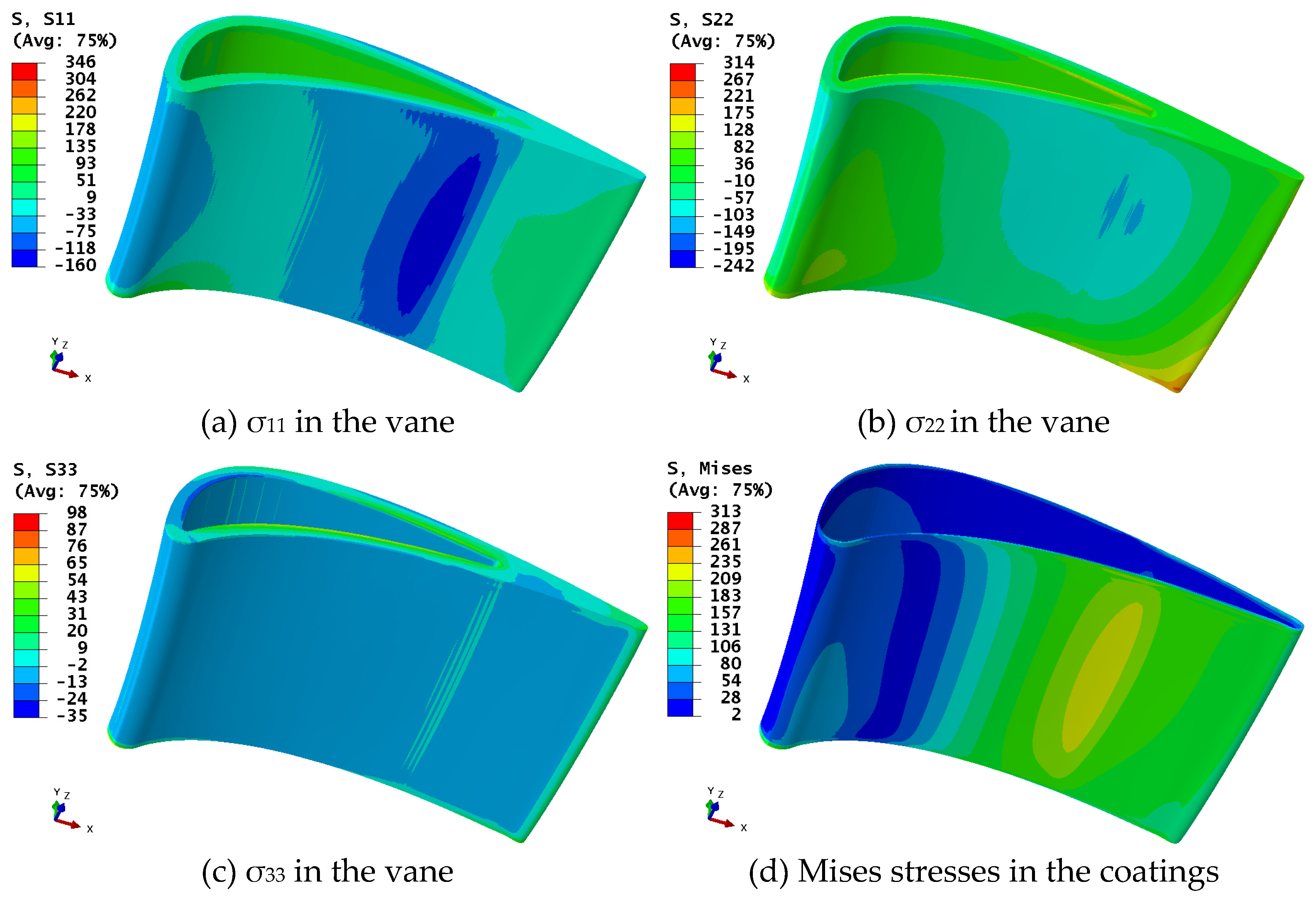
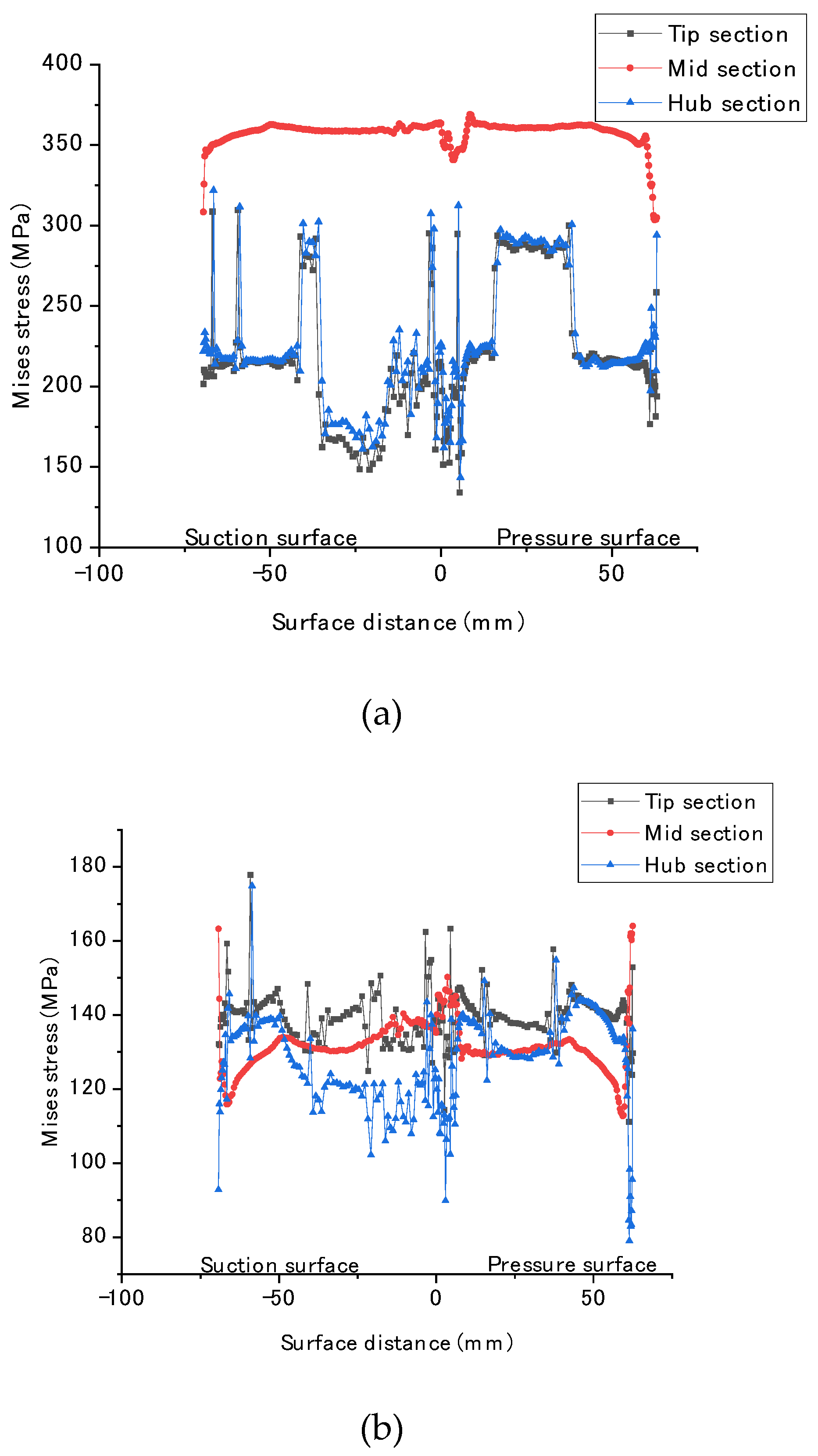



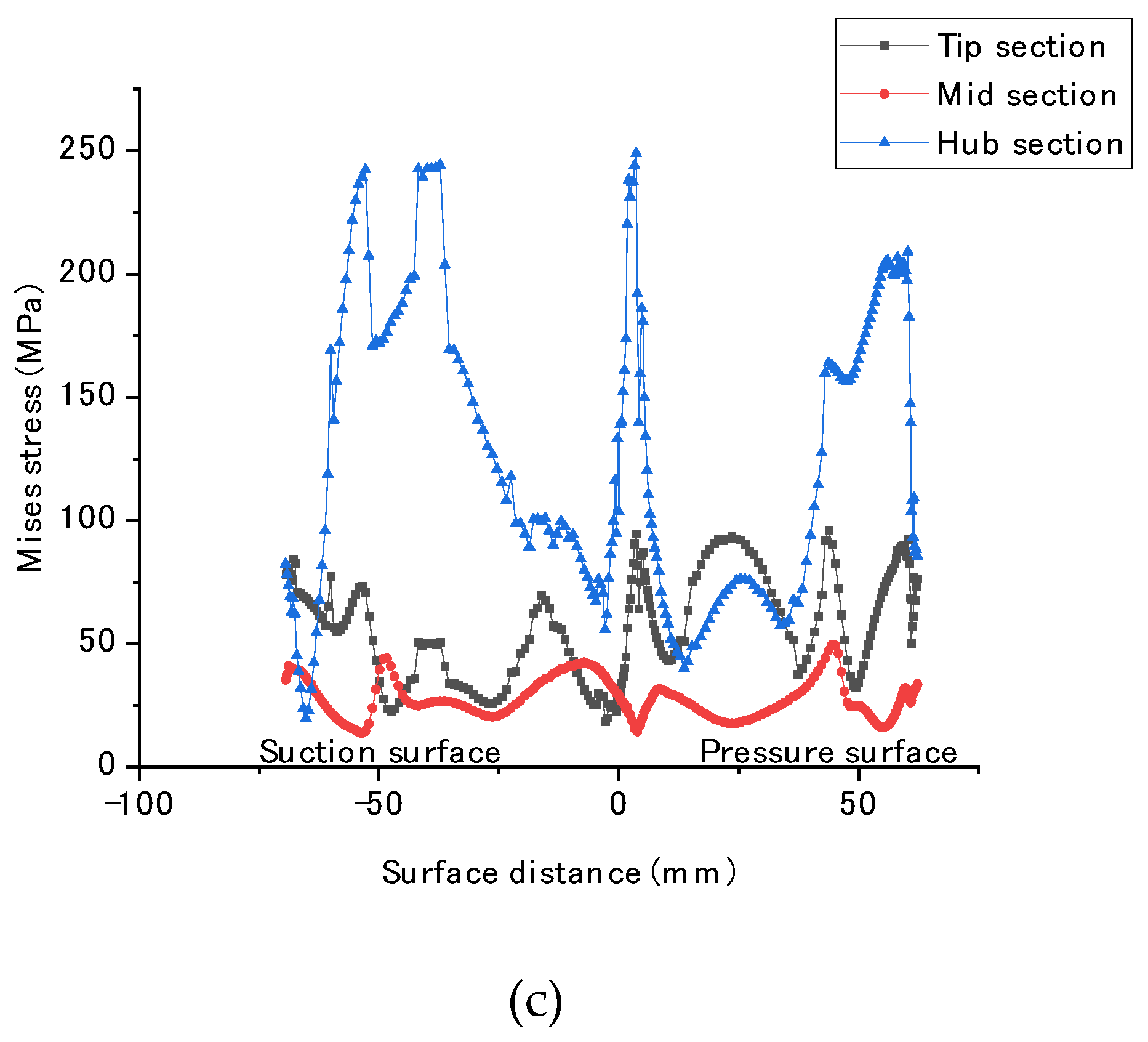
| Properties | Data | ||
|---|---|---|---|
| Elastic modulus, E, GPa | E1 = 239 | E2 = 239 | E3 = 81 |
| Poisson’s ratio, υ | υ12 = 0.20 | υ13 = 0.21 | υ23 = 0.21 |
| Shear modulus, G, GPa | G12 = 97 | G13 = 46 | G23 = 46 |
| Coefficient of thermal expansion, α, 1 × 10−6/°C | α1 = 4.36 | α2 = 4.36 | α3 = 3.80 |
| Thermal conductivity, k, W/(m·°C) | k1 = 12.1 | k2 = 12.1 | k3 = 8.83 |
| Constituents | La2Zr2O7 | Yb2Si2O7 | Mullite | Si |
|---|---|---|---|---|
| Elastic modulus, E, GPa | 63 | 200 | 150 | 97 |
| Poisson’s ratio, υ | 0.25 | 0.28 | 0.17 | 0.21 |
| Coefficient of thermal expansion 1, α, 1 × 10−6/°C | 9.1 | 5.5 | 5.8 | 3.5 |
| Thermal conductivity 1, k, W/(m·°C) | 0.87 | 3.5 | 3.5 | 14.23 |
Disclaimer/Publisher’s Note: The statements, opinions and data contained in all publications are solely those of the individual author(s) and contributor(s) and not of MDPI and/or the editor(s). MDPI and/or the editor(s) disclaim responsibility for any injury to people or property resulting from any ideas, methods, instructions or products referred to in the content. |
© 2024 by the authors. Licensee MDPI, Basel, Switzerland. This article is an open access article distributed under the terms and conditions of the Creative Commons Attribution (CC BY) license (https://creativecommons.org/licenses/by/4.0/).
Share and Cite
Chen, M.; Fang, G.; Gao, X.; Song, Y. Thermo-Mechanical Stress Distributions in a Ceramic Matrix Composites Turbine Vane Coated with Environmental Barrier Coatings. Coatings 2024, 14, 87. https://doi.org/10.3390/coatings14010087
Chen M, Fang G, Gao X, Song Y. Thermo-Mechanical Stress Distributions in a Ceramic Matrix Composites Turbine Vane Coated with Environmental Barrier Coatings. Coatings. 2024; 14(1):87. https://doi.org/10.3390/coatings14010087
Chicago/Turabian StyleChen, Mingzhu, Guangwu Fang, Xiguang Gao, and Yingdong Song. 2024. "Thermo-Mechanical Stress Distributions in a Ceramic Matrix Composites Turbine Vane Coated with Environmental Barrier Coatings" Coatings 14, no. 1: 87. https://doi.org/10.3390/coatings14010087
APA StyleChen, M., Fang, G., Gao, X., & Song, Y. (2024). Thermo-Mechanical Stress Distributions in a Ceramic Matrix Composites Turbine Vane Coated with Environmental Barrier Coatings. Coatings, 14(1), 87. https://doi.org/10.3390/coatings14010087







